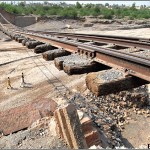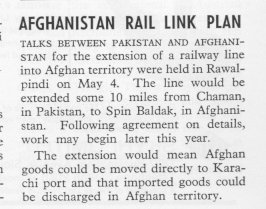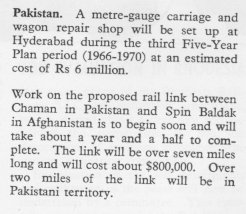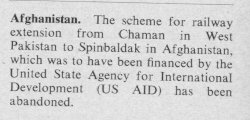In November 2008 Hail Ghulam Ahmad Bilour, Pakistan’s Railways Minister, told the National Assembly that two studies for railways were being considered.
One plan is to revive the long-standing proposal to extend the Pakistan Railways network by about 10 miles from the current terminus at Chamman to reach Spin Boldak across the border in Afghanistan, providing a railhead for Kandahar.
The other plan is much more substantial, being a 662 km link from Havelian in Pakistan to China via the Khunjerab Pass, which reaches an altitude of 4700 m. However it had been said in September that this route was not commercially feasible.
Pak-China rail link pre-feasibility study completed, National Assembly told
…
Bilour told the house in response to a question raised by MNAs including Fauzia Wahab, Muhammad Asad Khan, Yasmeen Rehman and Shereen Arshad Khan, that the PC-I for Chaman Spinbuldak (Afghanistan bordering town) rail link was completed with the cost of Rs 417 million in June 2004 and the project was to be executed by M/s Railcop, however, work could not be started due to non-issuance of NOC by Afghanistan government. The revised cost of PC-l is now assessed Rs 943.00 million, he added.
He said that the Pak-China Rail link pre-feasibility study has been completed through two consulting firms M/s L.L.F of German-Austria and M/s Don fang Electric Corporation (DEC) of China and following route has been recommended for detailed feasibility. Havelian-AbbotAbad – Batagram – Thakot-Bridge-Bèsham-Pattan -Dassu-Chillas – Gilgit-Karimabad – Sost-Mintaka Pass. The length of this route is 662 km and tentative cost is US $10.237 billion to be completed in 15 years, he informed.
[More]
Source: Business Recorder, 2008-11-11
There are more details of the feasibility studies in the February 2007 Asia Times Online article China-Pakistan rail link on horizon, by Syed Fazl-e-Haider. This says:
As a part of its development plan for its transport and communications network, Pakistan Railways has completed a feasibility study of the Chaman-Kandahar section for laying railway tracks between Pakistan and Turkmenistan through Afghanistan.
Source: Asia Times Online, 2007-02-24



